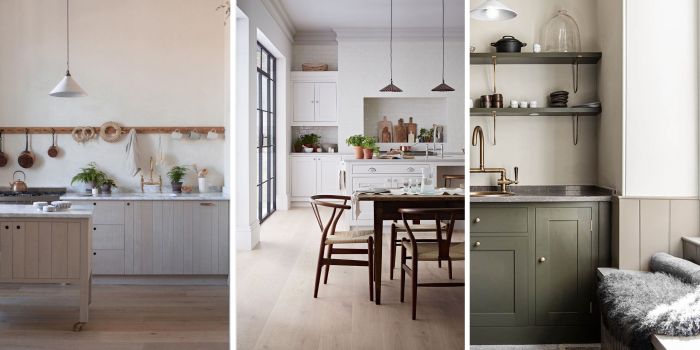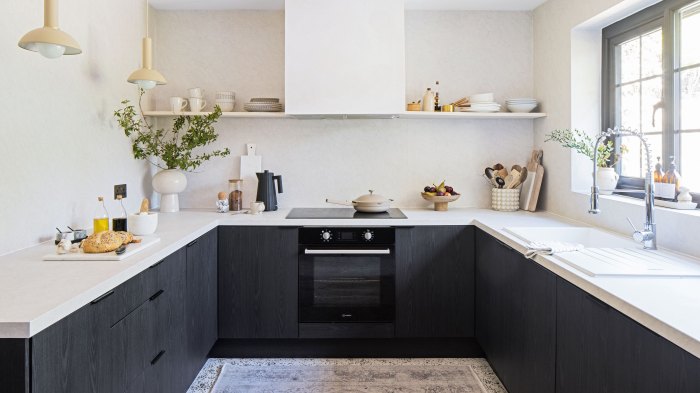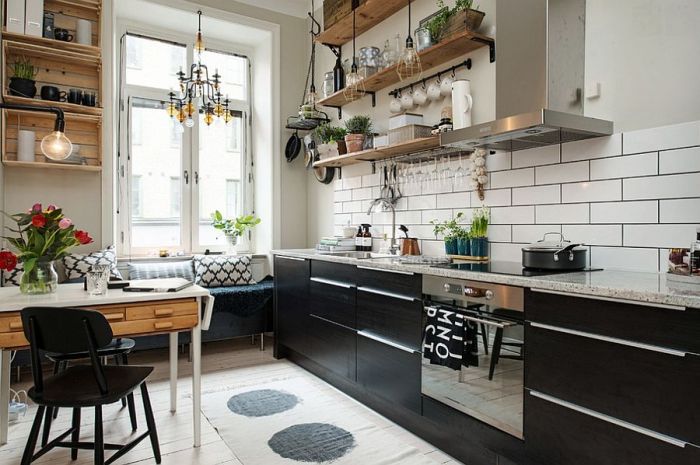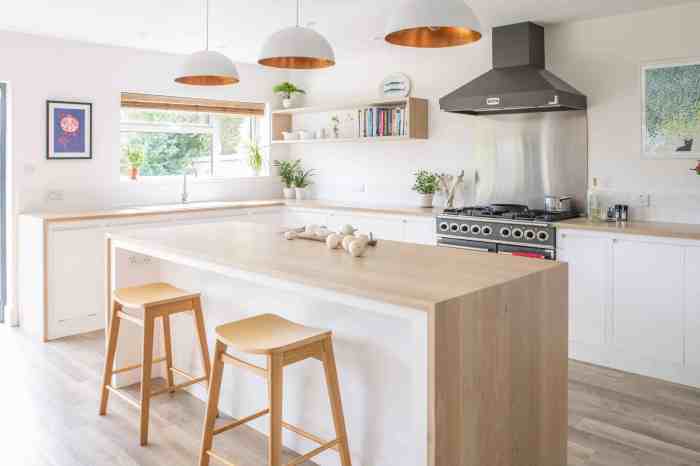The allure of Scandinavian design lies in its minimalist aesthetic, a philosophy that prioritizes functionality and natural light. This approach, deeply rooted in the region’s long winters and appreciation for nature, translates beautifully into the kitchen, a space often considered the heart of the home. We delve into the core principles of this style, exploring the materials, appliances, and organizational strategies that define a stylish and efficient Scandinavian kitchen, supported by the scientific understanding of how light, space, and material choices impact our perception and well-being.
From the careful selection of light woods and natural stone to the strategic placement of lighting fixtures that maximize natural illumination, every element contributes to a sense of calm and spaciousness. This guide will equip you with the knowledge to create a kitchen that is not only visually appealing but also highly functional, reflecting the practical yet elegant spirit of Scandinavian design.
We will explore the science behind the design choices, analyzing the impact of materials, color palettes, and spatial organization on the overall atmosphere and usability of the kitchen.
Defining “Stylish Scandinavian Kitchen Essentials”

Scandinavian design, renowned for its minimalist aesthetic and functional approach, translates seamlessly into the kitchen environment. This style prioritizes clean lines, natural materials, and a sense of calm and spaciousness, creating a kitchen that is both beautiful and practical. Understanding the core principles of Scandinavian design allows us to define the essential elements that contribute to a stylish and functional Scandinavian kitchen.
Core Aesthetic Principles of Scandinavian Kitchen Design
Scandinavian kitchen design is rooted in the principles of functionality, simplicity, and natural light. The emphasis is on creating a space that is both visually appealing and highly efficient. Light, neutral color palettes are favored, often incorporating whites, grays, and beiges, to maximize the feeling of spaciousness and allow natural light to reflect and brighten the room. Natural materials such as wood, stone, and linen are frequently used, adding warmth and texture while maintaining a sense of understated elegance.
Minimalist design principles ensure that only essential items are displayed, preventing clutter and maintaining a sense of order. The overall effect is a kitchen that feels serene, inviting, and effortlessly stylish.
Five Key Characteristics of a Stylish Scandinavian Kitchen
Five key characteristics define a stylish Scandinavian kitchen: (1) A light and airy atmosphere achieved through a neutral color palette and ample natural light; (2) The use of natural materials such as wood, stone, and linen to create a warm and inviting ambiance; (3) Clean lines and minimalist design, avoiding unnecessary ornamentation or clutter; (4) Functional and well-organized storage solutions that keep countertops clear and uncluttered; and (5) Incorporation of practical and aesthetically pleasing kitchenware, often featuring simple designs and high-quality materials.
Essential Kitchen Items in a Scandinavian Home
The following table categorizes essential kitchen items commonly found in Scandinavian homes, highlighting their material and function. The selection reflects the emphasis on practicality, durability, and understated elegance inherent in Scandinavian design.
| Category | Item | Material | Description |
|---|---|---|---|
| Cooking | Cast iron skillet | Cast iron | Durable and versatile, ideal for searing, frying, and baking. Often features a simple, unadorned design. |
| Cooking | Wooden spoons and spatulas | Wood (e.g., beech) | Gentle on cookware and add a touch of warmth to the kitchen. |
| Storage | Glass storage jars | Glass | Allow for easy viewing of contents and maintain a clean, organized look. |
| Storage | Bamboo cutting board | Bamboo | Sustainable and aesthetically pleasing alternative to plastic cutting boards. |
| Dining | Wooden serving bowls | Wood (e.g., oak) | Add a natural touch to meal presentation. Often feature simple, elegant designs. |
| Dining | White ceramic dinnerware | Ceramic | Classic and versatile, creating a clean and sophisticated table setting. |
| Cooking | Stainless steel saucepan set | Stainless steel | Durable and easy to clean, forming the basis of a functional cookware collection. |
| Storage | White ceramic canisters | Ceramic | Ideal for storing dry goods, maintaining a cohesive and organized pantry. |
Materials and Finishes
The inherent beauty of Scandinavian design lies in its masterful selection and application of materials. A focus on natural elements, durability, and functionality shapes the aesthetic, creating kitchens that are both visually stunning and incredibly practical. The interplay of textures and finishes, carefully chosen to complement the overall light and airy ambiance, is a defining characteristic.The choice of materials directly impacts the longevity and character of a Scandinavian kitchen.
The emphasis on sustainability and natural resources is reflected in the prevalent use of wood, stone, and metal, each contributing unique properties to the space. These materials, often treated with minimal processing to preserve their natural beauty, create a sense of calm and connection to the natural world.
Wood Selection and its Impact on Kitchen Ambiance
Light and dark woods play distinct roles in shaping the mood and feel of a Scandinavian kitchen. Light woods, such as birch and ash, are frequently employed for their ability to reflect light, maximizing the brightness and spaciousness of even smaller kitchens. Their pale hues contribute to a feeling of openness and serenity. Imagine a kitchen bathed in soft, natural light, with pale birch cabinets reflecting the sun’s rays, creating a bright and airy atmosphere.
This is a classic example of how light wood enhances the Scandinavian aesthetic. In contrast, darker woods, like walnut or oak, introduce a sense of warmth and sophistication. Their rich tones add depth and visual interest, grounding the space and creating a more intimate feeling. A kitchen featuring dark oak cabinetry might incorporate lighter countertops and backsplashes to maintain balance and prevent the space from feeling too heavy.
The contrast between the dark wood and lighter elements creates a sophisticated and inviting ambiance.
Color Palettes and their Contribution to Light and Airiness
Scandinavian kitchen color palettes typically favor a restrained and harmonious approach, prioritizing neutral tones that enhance the sense of light and airiness. Whites, creams, and light grays are foundational, acting as a backdrop for the natural materials and pops of color. These light colors reflect light effectively, creating a feeling of spaciousness. The incorporation of muted pastels, such as soft blues, greens, or pinks, adds subtle warmth and personality without overpowering the overall minimalist aesthetic.
These colours often appear in accessories, textiles, or smaller elements, preventing the space from becoming overly saturated. For example, a kitchen with white cabinets and light grey walls might feature pastel blue kitchen towels or a green vase with fresh flowers, adding a touch of color without compromising the overall clean and uncluttered look. The strategic use of color amplifies the sense of space and tranquility, aligning perfectly with the Scandinavian design philosophy.
Stone and Metal Accents
Stone, often in the form of countertops or backsplashes, adds a touch of natural texture and durability to the Scandinavian kitchen. Materials like marble, granite, or soapstone are popular choices, their veining and natural variations adding visual interest. The cool tones of stone complement the warmth of wood, creating a balanced and sophisticated aesthetic. Metal accents, typically in brushed stainless steel or matte black, add a contemporary touch and contribute to the functional aspect of the design.
These elements often appear in hardware, lighting fixtures, or appliances, providing subtle contrasts against the lighter tones of the cabinetry and walls. The combination of stone and metal adds a sense of understated elegance, further enhancing the overall sophisticated and functional character of the Scandinavian kitchen.
Key Appliances and Gadgets
The functionality and aesthetic appeal of appliances are paramount in achieving a stylish Scandinavian kitchen. Prioritizing both efficiency and minimalist design, Scandinavian kitchens typically feature a curated selection of appliances that seamlessly integrate into the overall aesthetic. These appliances are chosen not just for their performance, but also for their ability to enhance the clean lines and uncluttered feel characteristic of the style.
Five essential appliances commonly found in stylish Scandinavian kitchens are the induction cooktop, built-in refrigerator, integrated dishwasher, multi-functional oven (often a combination steam and convection oven), and a quiet, powerful extractor hood. The induction cooktop offers precise temperature control and rapid heating, aligning with the Scandinavian emphasis on efficiency. Its sleek, flat surface contributes to the minimalist aesthetic. The built-in refrigerator, typically featuring a stainless steel or matte white finish, maintains a streamlined appearance while providing ample storage.
An integrated dishwasher, discreetly hidden within cabinetry, maximizes space and minimizes visual clutter. The multi-functional oven, often boasting a minimalist control panel, offers versatility and reduces the need for multiple appliances. Finally, a powerful yet quiet extractor hood ensures efficient ventilation without disrupting the serene atmosphere of the kitchen.
Examples of Minimalist Kitchen Gadgets
Minimalist kitchen gadgets, echoing the Scandinavian design philosophy of form following function, prioritize simplicity and practicality. These tools are carefully selected for their efficiency and ability to enhance the cooking experience without overwhelming the workspace.
- A simple, wooden cutting board: Often made from sustainably sourced beech or maple, offering both durability and natural beauty. Its unadorned design complements the clean lines of a Scandinavian kitchen.
- A set of high-quality stainless steel knives with minimalist handles: These knives emphasize functionality over ornamentation, providing sharp, precise cutting tools without unnecessary embellishments.
- A single, well-designed utensil holder: A sleek, ceramic or stainless steel holder keeps essential cooking utensils organized and readily accessible, avoiding the clutter of multiple containers.
- A minimalist spice rack: A small, wall-mounted rack or a single, slender container neatly stores spices, keeping them visible and easily accessible while maintaining a clean, uncluttered look.
- A simple, ceramic mortar and pestle: This classic tool allows for the preparation of spices and ingredients with a focus on natural materials and a streamlined design.
Small, Functional Kitchen Island Design
A small, functional kitchen island, designed in the minimalist Scandinavian style, can serve as a central hub for food preparation and storage. The island’s design emphasizes clean lines, natural materials, and a neutral color palette.
Imagine a kitchen island crafted from light oak wood, with a butcher block countertop. Its dimensions are approximately 48 inches long by 24 inches wide and 36 inches high. The island incorporates two drawers for cutlery and utensils, made from the same light oak. Beneath the countertop, a section houses a built-in induction cooktop, while the other side features open shelving for displaying cookbooks or decorative items.
The island is painted in a soft, matte white, creating a visually calming effect. The overall design prioritizes functionality and storage efficiency while maintaining a clean, uncluttered aesthetic that reflects the principles of Scandinavian design.
Storage and Organization

Maintaining a clean and uncluttered aesthetic in a Scandinavian-style kitchen hinges on intelligent storage solutions. The principles of functionality and minimalism, central to Scandinavian design, dictate that storage should be both efficient and visually appealing, seamlessly integrating into the overall design rather than detracting from it. Effective storage maximizes space utilization, minimizes visual clutter, and promotes a sense of calm and order—essential components of the Scandinavian ethos.Effective storage solutions in a Scandinavian kitchen prioritize both functionality and aesthetics.
A key principle is to keep surfaces clear and uncluttered, creating a sense of spaciousness. This is achieved through a combination of clever design and thoughtful organization. The strategic use of both open and closed storage creates a visually balanced system, maximizing the advantages of each while minimizing their drawbacks.
Open Shelving and Closed Cabinetry: A Balanced Approach
The integration of open shelving and closed cabinetry offers a powerful strategy for achieving a balanced storage system in a Scandinavian kitchen. Each type of storage possesses unique strengths and weaknesses that, when carefully considered and combined, contribute to an optimal outcome.
- Open Shelving: Advantages: Open shelving offers immediate visual access to frequently used items, fostering efficiency. It also provides an opportunity to showcase beautiful, high-quality cookware or tableware, adding to the overall aesthetic appeal of the kitchen. The visual lightness of open shelving contributes to a feeling of spaciousness, especially in smaller kitchens.
- Open Shelving: Disadvantages: Open shelving requires meticulous organization and maintenance to prevent clutter. Items must be carefully curated to maintain a visually appealing display, and regular cleaning is essential to avoid dust accumulation. Open shelving may not be suitable for storing items sensitive to light or moisture.
- Closed Cabinetry: Advantages: Closed cabinetry provides ample storage space for less frequently used items or those that are better kept hidden from view. It protects items from dust, moisture, and light, extending their lifespan. Closed cabinetry contributes to a cleaner, more streamlined look, particularly beneficial for those who prefer a minimalist aesthetic.
- Closed Cabinetry: Disadvantages: Closed cabinetry can feel less accessible than open shelving, potentially slowing down workflow. It can also make it harder to locate specific items, leading to wasted time and frustration if not properly organized. Overly full cabinets can appear cluttered even when closed, negating the desired minimalist effect.
A balanced approach typically involves using closed cabinetry for less frequently used items and open shelving for frequently accessed items and aesthetically pleasing pieces. This strategy minimizes the disadvantages of each storage type while maximizing their benefits. For example, everyday dishes and frequently used cooking utensils could be displayed on open shelves, while less frequently used appliances or pantry staples could be stored in closed cabinets.
Organizing Kitchen Utensils and Cookware
The organization of kitchen utensils and cookware is crucial for maintaining a functional and aesthetically pleasing Scandinavian kitchen. The principles of minimalism and functionality dictate that only essential items are kept, and those items are stored in a way that maximizes accessibility and minimizes clutter.Several organizational methods can be employed:
- Drawer Organizers: Utilizing drawer dividers and organizers allows for the efficient storage of utensils, cutlery, and smaller cooking tools. This keeps items separated, preventing tangling and maximizing space. Choosing dividers made from natural materials, such as bamboo or wood, complements the Scandinavian aesthetic.
- Vertical Storage: Employing vertical storage solutions for pots, pans, and cutting boards maximizes space utilization and keeps items readily accessible. Using stackable containers or hanging racks for pots and pans is a particularly effective method.
- Decluttering and Purging: Regular decluttering and purging of unused or duplicate items is paramount. This ensures that only essential items are kept, promoting a clean and uncluttered workspace. The “one in, one out” rule can be a helpful guideline for maintaining a minimalist approach.
The goal is to create a system where everything has its designated place, making it easy to find and put away. This contributes to both efficiency and the overall sense of order that is characteristic of a well-designed Scandinavian kitchen. By adhering to these principles, one can create a kitchen that is both functional and visually appealing, reflecting the core values of Scandinavian design.
Lighting and Ambiance

The Scandinavian aesthetic, celebrated for its minimalist design and emphasis on natural elements, places significant importance on the interplay of light and shadow in the kitchen. The long, dark winters of Scandinavian countries necessitate a strategic approach to lighting, aiming to create a bright, inviting, and functional space that combats the seasonal lack of sunlight. This involves maximizing natural light sources and thoughtfully integrating artificial lighting to complement and enhance the overall ambiance.The impact of natural light on mood and well-being is well-documented.
Studies have shown that exposure to natural light improves circadian rhythm, boosts serotonin levels (contributing to feelings of happiness and well-being), and increases productivity. In the kitchen, where daily tasks and social gatherings often take place, ample natural light is paramount for creating a positive and energizing environment.
Maximizing Natural Light and Artificial Light Integration
Maximizing natural light in a Scandinavian kitchen involves strategic window placement and the use of light-colored, reflective surfaces. Large windows, ideally facing south or east, allow maximum sunlight penetration. Using light-colored paint on walls and cabinetry reflects light, creating a brighter space. Sheer curtains or blinds can diffuse harsh sunlight while still allowing ample light to enter.
Mirrors strategically placed near windows can further amplify the effect of natural light, bouncing it deeper into the room. However, even with maximized natural light, artificial lighting is crucial, particularly during the darker months or evenings. This supplementary lighting should be carefully chosen to complement the natural light and maintain the desired ambiance. A layered approach, incorporating ambient, task, and accent lighting, ensures optimal illumination and visual appeal.
Types of Lighting Fixtures in Scandinavian Kitchens
Scandinavian kitchens often feature a combination of lighting fixtures to achieve a balanced and functional lighting scheme. Pendant lights, with their clean lines and minimalist design, are frequently used as statement pieces above kitchen islands or dining tables. Recessed lighting provides even, general illumination throughout the space, avoiding harsh shadows. Under-cabinet lighting is essential for task illumination, illuminating work surfaces for food preparation.
Track lighting offers flexibility, allowing for adjustable light placement to highlight specific features or areas. The choice of materials, typically featuring metal finishes like brushed nickel or matte black, reflects the minimalist aesthetic. The visual impact of each fixture contributes to the overall atmosphere; pendant lights create focal points, recessed lighting provides functional illumination, and under-cabinet lighting ensures task-oriented brightness.
A Scandinavian Kitchen Lighting Scheme Example
Imagine a kitchen with large, south-facing windows, allowing ample natural light to flood the space during the day. Three brushed nickel pendant lights hang above a central island, providing soft, ambient lighting for dining or casual gatherings. Recessed lighting in the ceiling ensures even illumination throughout the kitchen, preventing dark corners. Under-cabinet lighting, with energy-efficient LED strips, provides focused task lighting over countertops and the sink area.
A small, adjustable track light system is positioned near a wall-mounted spice rack, highlighting the collection and adding a touch of visual interest. The overall ambiance is bright, airy, and inviting, reflecting the core principles of Scandinavian design. The carefully selected lighting fixtures, combined with the strategic use of natural light and reflective surfaces, creates a space that is both functional and aesthetically pleasing, promoting a sense of calm and well-being.
Illustrative Examples

The following examples showcase the versatility of the stylish Scandinavian kitchen aesthetic, demonstrating its adaptability to various spaces and personal preferences while adhering to core design principles. Each example illustrates how the interplay of light, natural materials, and minimalist design can create a functional and visually appealing space.
A Bright and Spacious Scandinavian Kitchen
Imagine a kitchen bathed in natural light, thanks to a large window overlooking a verdant garden. Light oak cabinets, their grain subtly visible, extend from floor to ceiling, maximizing storage while maintaining a sense of airiness. Minimalist countertops of honed Carrara marble provide a cool contrast to the warm wood, their smooth surface reflecting the light and creating a sense of spaciousness.
Integrated appliances, such as a sleek induction cooktop and a quiet dishwasher, maintain the clean lines of the design. Pendant lights, crafted from simple, geometric shapes and featuring warm-toned LED bulbs, hang above the island, providing focused task lighting. The overall atmosphere is one of serene calm, enhanced by the soft, natural light and the carefully chosen materials.
The color palette is predominantly white, light gray, and natural wood tones, creating a feeling of spaciousness and tranquility. The subtle textural contrast between the smooth marble and the slightly rougher wood adds visual interest without overwhelming the minimalist aesthetic.
A Compact and Efficient Scandinavian Kitchen
This kitchen, designed for a smaller space, prioritizes functionality and clever storage solutions. Pale gray cabinetry, fitted to the walls and extended to the ceiling, optimizes vertical space. Open shelving displays carefully curated tableware and adds visual interest, while deep drawers provide ample storage for pots, pans, and other kitchen essentials. A pull-out pantry system maximizes the use of corner space.
The countertops, made of a durable yet visually appealing laminate in a light gray tone, mirror the cabinetry, creating a sense of visual unity. A compact, integrated refrigerator and a small, efficient oven maintain the streamlined aesthetic. Under-cabinet lighting provides functional illumination, while a single, stylish pendant light serves as an ambient light source. The overall effect is one of efficient use of space and understated elegance.
The color palette is limited to grays, whites, and a subtle accent color, such as a muted teal or a soft blush pink, used sparingly in textiles or small decorative items.
A Scandinavian Kitchen Embracing Nature
In this kitchen, natural elements take center stage. Light-colored wood cabinets, perhaps birch or ash, are paired with countertops made from a sustainable material like bamboo or reclaimed wood. Live-edge shelving adds a touch of organic texture and visual interest. Potted plants of varying heights and textures are strategically placed, introducing a touch of greenery and improving air quality—a scientifically proven benefit of indoor plants.
The incorporation of natural materials, such as woven baskets for storage and linen textiles for towels, adds warmth and tactility to the space. The lighting is soft and diffused, mimicking natural daylight. The overall atmosphere is calming and inviting, reflecting the restorative power of nature. A neutral color palette, with subtle variations in shades of green and brown, enhances the feeling of being connected to the natural world.
The inclusion of natural elements such as plants contributes to improved air quality by reducing carbon dioxide levels and increasing humidity, factors which positively affect well-being and productivity, according to research published in the Journal of Environmental Psychology.
Outcome Summary
Creating a stylish Scandinavian kitchen is about more than just aesthetics; it’s about crafting a space that nurtures well-being and enhances daily life. By understanding the core principles of this design philosophy—minimalism, functionality, and the strategic use of natural light and materials—you can transform your kitchen into a haven of calm and efficiency. The principles explored, from the thoughtful selection of appliances and storage solutions to the strategic placement of lighting, all contribute to a harmonious and functional space.
The result is a kitchen that is not only beautiful but also a joy to use, reflecting the enduring appeal of Scandinavian design.
Q&A
What are some sustainable choices for a Scandinavian kitchen?
Sustainable choices include using reclaimed wood, bamboo countertops, energy-efficient appliances, and choosing locally sourced materials whenever possible. This minimizes environmental impact while maintaining the aesthetic.
How can I incorporate Scandinavian design into a small kitchen?
Maximize vertical space with tall cabinets and open shelving. Utilize light colors to create an illusion of spaciousness. Multifunctional furniture, like a kitchen island with integrated storage, can save space while maintaining functionality.
What are some common mistakes to avoid when designing a Scandinavian kitchen?
Overcrowding the space with too many items, neglecting natural light, and using overly dark or busy color palettes are common pitfalls. Maintaining a sense of openness and simplicity is key.
How can I achieve the right lighting in a Scandinavian kitchen?
Maximize natural light by using sheer curtains or blinds. Supplement with layered artificial lighting: recessed lighting for general illumination, pendant lights for task lighting, and accent lighting to highlight features.
Where can I find high-quality, Scandinavian-inspired kitchenware?
Many online retailers and specialty stores offer a wide range of Scandinavian-designed kitchenware. Look for brands known for their minimalist designs and high-quality materials.
